Friday, December 7, 2012
The Legwarmers
On December 1, a Saturday night, I went out to Falls Church, VA to see an amazing 80’s cover band called the Legwarmers. The Legwarmers formed in May of 2001 and have taken DC by storm since then. At their performances, the audience comes dressed up in their ultimate 80’s gear.I was no exception, and dressed up in my skirt with leggings, tennis shoes and of course a side ponytail.I saw a plethora teased hair, legwarmers, sweatbands, and shoulder pads. All this adds to the experience of traveling back in time to the 1980’s with the fabulous music played by the band. Throughout the night they played the classic 80s music from stars like Madonna, Cyndi Lauper, Blondie. My favorite songs that got the crowd going were Ozzy Osbourne’s Crazy Train, Cyndi Lauper’s Girls Just Wanna Have Fun, and Survivor’s Eye of the Tiger. The the lead female vocalist, Cyndi Sindee sounds just like Cyndi Lauper! She was rockin an awesome Madonna outfit too. The guitarist were amazing too. Gordon Gartrell played the guitar solo in Ozzy Osbourne’s Crazy Train, and he killed it! Every band member held was great and held their own. Here is a list of the band members and their forte:
Chet Reno - Bass / Vocals
Cru Jones - Guitar / Vocals
Cyndi Sindee - Vocals / Percussion
Gordon Gartrell - Guitar/Vocals
Lavaar Huxtable - Drums
Capt. Morgan Pondo - Keyboard
Clarence McFly - Tenor Sax
Each band member played a specific character related to 80’s pop culture. For example, “Capt” Morgan Pondo was dressed as though he stepped off of Gilligan's Island and again Cyndi Sindee dressed up as Madonna. Overall, I loved dancing and listening to the music. I had a blast at the performance and will definitely return to hear them again in the future.
Thursday, December 6, 2012
Latin Music
Afro Cuban All Stars
The Afro Cuban All Stars was a group that flourished under
the tourist trade between the U.S.
and Cuban before the Cuban Revolution. They reemerged in the 90’s when they
were recorded. I listened to their album, A
Toda Cuba Le Gusta, which translates to “Everyone in Cuba Likes it”. The entire album made me
want to dance, even the slower songs like, “Habana del Este”. I enjoyed the
flute in the song and you can definitely hear the clave keeping the beat in it.
I really like how in “Maria Caracoles” it opens with the bong drums and the
rest of the percussion comes in followed by the horns and so forth. It is a
party song to me. I have found that through listening to this album, I really
enjoy this group!
Jazz
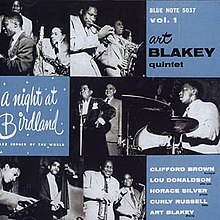
Art Blakey 1919-1990
Art Blakey was a renowned jazz musician and his music is
still widely appreciated today. He
commanded the drums in the jazz world. I listened to the live album, A Night at Birdland. From the first
song, “Split Kick” Art’s skill is evident. The drums carry the bass line and
give it a snazzy feel. The whole album has the big band jazz feel. I enjoyed
the extra history Art gave about playing “A Night In Tunsia”, that he was with
Dizzy Gillespie when Dizzy wrote the song. I love the trumpet in “Mayreh”. It
is paired perfectly with the drums.
Romantic Era

Franz Liszt 1811-1886
Franz Liszt was a Hungarian Piano Virtuoso during the Late
Romantic Era. I listened to Horowitz
Plays Liszt. My favorite piece was “Piano Sonata in B minor”. The beginning
is very dramatic as it starts out slow then jumps into music with loud piano
keys crashing down. Not quite halfway through the first part in the Allegro
energico, the drama ceases into what I view as a stroll across the pond. Very
soft notes on the piano are played with much of the moving up down across the
keys. The range begins to pick up around the halfway point, but the music is
still calmer than the opening. At one point, it sounds like fairies are flying
around. Then the drama picks back up in a dramatic fashion. The second part Andante
sostenuto, starts out calm then gets dramatic for a few minutes but afterwards
it stays relatively calm. It amazes me how a pianist can play those notes on a
piano, the sound is so complex and fast. The complexity can be heard in throughout
the third part, Allegro energico (fugato). The music is beautiful and amazing
at the same time. I don’t know how Horowitz fingers did not fall off playing
this piece!
Baroque Era
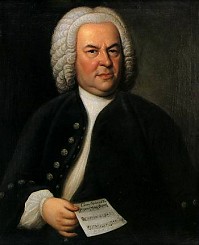
Johann Sebastian Bach (1685–1750)
Johann Sebastian Bach was the most influential Baroque era
composer. In a period that was overly ornate and frilly, Bach was not household
name until well after his death. I listened to a playlist on Spotify of Bach’s
music performed by various groups. Included in my most enjoyed songs that I
listen to is “Orchestral Suite No 3. in D minor”. This music flows very
sweetly. I feel like I am in the music hall of a great palace, watching
servants go to in fro in the graceful manner befitting such a place. The music
is proper and lovely at the same time. The song, Suite No 1 in G Major, reminds
me of someone galloping on a horse to attend to urgent business, but elegantly.
It seems like this to me because of the cello being the highlighted. When the
notes are lower, it sounds like conflict. The end resolves itself nicely.
Medieval Music
The Plainchant, also known as Gregorian chant, is the
earliest forms of written music there were. It was religious in nature and used
in religious services. However, there were some secular songs during this
period. The earliest composers and chanters were Leonin and Perotin. I listened
to the Notre-Dame Catheredal’s choir. The plainchant, Viderunt Omnes had no music. I found it very calming like the rest
of the album. Throughout the entire album, I found the music normally has just
main person and everyone else is in the background. Their voices are the only
instruments making music. The entire album is lovely. I particularly enjoyed, Viderunt Omnes No2 salutare suum ante
conspectum gentium relevati
because it sounds so angelic with the high notes. I am pretty sure it sung by
women
Tuesday, November 27, 2012
Miles Davis and John Coltrane

Miles Davis and John Coltrane are both legends in the world
of Jazz. The former was the mentor of the latter. They both have a scattered
sound and use dissonance in their composition. The music sounds jumbled
together in nonsense, yet it all works and is actually enjoyable. A good
example would be Miles Davis’s Spanish Key on Bitches Brew. A horn instrument is normally always the main
instrument in both Davis
and Coltrane’s music. Many of their songs are similar as well. For example, I
think Coltrane’s “Equinox” is also very similar to Davis ’s “Flamenco Sketches (Alternative
Take)”. Also, John Coltrane’s performance of “Afro-Blue” in 1963 sounds very
similar to Davis ’s
“Freddie Freeloader” on Kind of Blue.
Both songs have a competing feel to it, almost as if all the instruments are
competing against one another to have their voice heard. However, in Coltrane’s
“The Father and The Son and The Holy Spirit”, the music is so disjointed it is
annoying and I have to skip through it. At some points in the song, seven
minutes in for instance, it sounds as though a donkey is dying. The end of the
song is the death of the donkey. I prefer softer ballads, such as Coltrane’s
collaboration with Duke Ellington in “In a Sentimental Mood”, just lovely. Although Miles Davis accomplished more than
John Coltrane did in volume and extent of his work, I believe Coltrane would
have been just a big of musical force that Davis was, if he had not passes away
so early.
Sunday, November 25, 2012
Louis Armstrong

Louis Armstrong is known as one of the fathers of Jazz. His
distinct voice is recognizable across generations. Heralded as one of the
greatest trumpet players, Armstrong’s music is as much enjoyable today as it
was during his lifetime in the early to mid 20th Century. Most of
his compilations have a heavy Dixieland Jazz feel to it, except some of his
duets. The trumpet is obviously the main instrument in almost all the songs I
listened to. In “Muggles”, the trumpet and clarinet trade off in the middle for
carrying the melody, but it quickly returns to the trumpet. Some other songs
are the same as that, but the trumpet is still the highlight overall. Some
things I found interesting were in the song “Knocking on a Jug”, the baseline
is actually kept by what seems like tapping on a jug! Also in “Sugar Foot
Strut”, the song starts with glass jars being used as drums and picks back up
before Louis sings (I could not understand all the lyrics). It sounds as though
they are playing in the street, which gives it a cool St. Louis feel. I really enjoy when Louis
scats in duets, such as in “They Can’t Take That Away From Me” with Ella
Fitzgerald. The trumpet is kind of a backup in this song too. It is heard, but
the person singing is the main focus. Overall, I love Louis Armstrong!
Sunday, November 11, 2012
Music of the 20th Century
Maurice Ravel
Le Tombeau de Couperin
1.The Prelude: opens with mainly woodwinds but there is a
pentatonic scale on the piano being played as well right at the beginning. The feel starts out very
light and airy and as the the strings play it feels like the opening of a soft
dance.
2. Forlane: Begins with strings and woodwinds taking turns
carrying the melody. The strings and the woodwinds almost seem like two dancers
in a dance.
3.Menuet: The Harp plays a more front position in this
movement. The harp gives and angelic input. The clarinet is the main instrument
throughout though.
4. Rigaudon: The tempo is faster. Most notable are the
different woodwind instruments taking different solos when the tempo slows down
half way through. At the end, the tempo picks back up and all the instruments
return.
Gustav Mahler
Symphony No 5.
Allegro Maestoso: About 2 min in the music transitions to a
softer melody with strings, I think its beautiful, however it is quick followed
by dissonance as though as struggle as begun. Horn follow the dissonance it is
seems as though the struggle was gloriously won. The music becomes softer as
though a conversation is occurring. Then a short break occurs with mainly
strings coming in followed by horns. It stays soft and flowing for a while with
an oboe solo. After the solo it gradually picks up with percussion coming in.
The music repeatedly crescendos and decrescendo, leading to a breaking point,
followed by a softer melody and horns taking some of the lead. Half way through
is a break in the music followed by dramatic percussion and another pause in
the music. The following music sounds as though some one is creeping up behind
someone, almost spying on them. But the music into a glorious type of sound
followed by struggle and almost battle marching music. At about 14:30 the music
becomes VERY dramatic followed by a brief halt. The music picks back up and
leads yet again to another tipping point. Strings begin to settle the music
with the horns continuing the soft melody. The music pauses and the last minute
seems to set up the next part with the end being a quick dramatic ending.
Friday, November 2, 2012
Ludwig van Beethoven
Beethoven’s 5th Symphony
Movement I
2:15-2:30: it goes from the violins to the just the horns
and the dynamics drop and it goes into a soft melody. The horns sound like a
prince or a king is entering the room. Then the soft music and instruments seem
to begin a dance begins.
Movement II
00:58- 1:18 The music is starts to crescendo. It sounds like
an inspiring moment as though something great is about to happen. Then the drum
rolls and the horns get louder and it is as if the grand moment is occurring,
followed by some procession.
Movement III
2:15- 2:24 Just the strings begin to play starting with the
cellos. The deep sound of the cello coupled feels like a break in the music.
The violins and other strings begin to come in and add more contrast but they
also seem to chase each other as well.
Movement IV
5:20-5:36: The music before this time has just ended in what
sounds like a procession. But starting around here, the strings are played
softly as though a whisper is being imitated and followed by a quick dissonant
notes played louder almost to imitated a sharp response to the whisper.
Throughout Beethoven’s life I found the end particularly
striking. The multitude of pain he suffered and the various illnesses he could
have had is astounding to me. The ending of his life, which probably turned out
to be just a “brain irritation” from his liver failure is quite astounding.
Even more so than that, it was not until the last 10 years of his life in his
deafness, that he composed his most famous and greatest works. The harder
Beethoven’s life was the more brilliant he became. Then again, his life started
out with quite a bit of difficulty considering the abuse from his father.
Sunday, October 7, 2012
Madonna

Like a Prayer, 1989
Madonna has been a huge influence on music since her debut
in the 80s. MTV helped launch her career as well as the controversy that always
seems to surround her. Madonna grew up Catholic and drew from that experience
for this album Like a Prayer, in the album,
Madonna keeps her tradition of stirring up controversy especially with relation
to religion. In the song Like a Prayer,
she gives a gospel feel to it by adding a choir in at the end. It is very
sacrilegious considering she is singing about sexual desire. ..it is Madonna.
Even in Promise to Try, it reminds me
of a hymn. It is very simple with a piano and strings. Except that song, the
album has an electronic dance feel to it, even in some of the slower tempo
songs like Love Song. In that song,
it almost makes you want to crump with the distorted beats in parts of it. Madonna message throughout the album is about
empowering women to stand up and take charge of their lives and getting the
best from it instead of bowing to the demands of men.
Sunday, September 30, 2012
Grace Slick and The Great Society
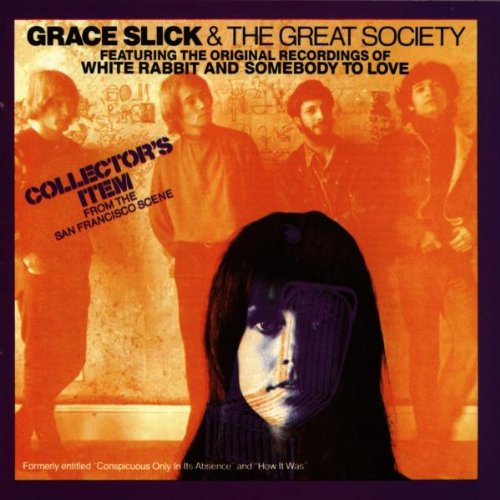
Collector's Item 1971
Grace Slick and The Great Society was a band in 1965-1966.
Grace Slick was the lead singer but went to Jefferson Airplane to replace Singe
Anderson. Jefferson Airplane recorded the two biggest songs The Great Society
sung, White Rabbit and Someone to Love, since Grace Slick
composed the songs.
In Someone to Love
the guitar and drums feel like they are each doing their own thing, yet it still
seems to work together. The chorus bridges the gap between them the most. It is
an interesting song. The song Sally Go ‘Round
the Roses’ has an Indian feel to it, it is unique. There is a lot of
dissonance in the song and what sounds like distortion of the guitar. I enjoyed
it
White Rabbit feels
like a snake charmer. Visualizing the music in my head, I see people sitting on
carpets in the desert charming snakes and smoking hookah at sunset. The lyrics
are in the last two minuets of the six-minuet song, a big lead up to a few
words at the end.
Overall, the recordings have a rusty sound to them. It seems
like the band is in a garage recording music. To me, it gives an amateurish
feel that is pure instead fraudulent. The music is carefree, open and unplanned
just like the era it was made in.
Sunday, September 23, 2012
The Beatles
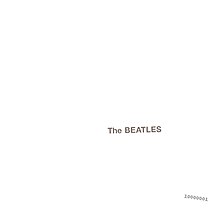
The Beatles (aka The White Album)
1968
The Beatles wrote this album after they traveled India . At the
time they were recording the album the band began to fall apart. According to
author Mark Lewisohn, Ringo Starr actually quit the band during some of the
recording of some the songs so Paul McCartney plays the drums on some of those
songs. I found some of the elements The Beatles incorporated into their
interesting and odd. In Back in the USSR
I like Martha My Dear.
It starts out with a few instruments and gradually adds more instruments into
the song. I like the stop time with the tuba in song, it has a playful feel to
which I think is appropriate sense they refer to Martha as a silly girl.
I love Blackbird! I think that is because I have heard it so
much and in movies it’s always played during a inspirational/crossroads moment.
The song has an inspirational feel to in the lyrics and instrumentation. They
also incorporate singing birds moving water sounds into the song. It makes me
think of a dawn breaking by a creek in a peaceful forest. The simple sound of
the tap on a wooden block (which keeps the beat in the song) also contributes
to the inspirational and peaceful feel of the song.
Sunday, September 16, 2012
Rock N Roll

Elvis Presley 1956
This self titled album was
the King’s first recorded album. This first album launched Elvis’s career and
stardom. Today people still considered Elvis Presley as the King of Rock N
Roll, which is fitting considering the sex spell he cast upon the females of
the 1950’s according to many churches of the day. His music makes you want to
shake and sway your hips. In Tutti Frutti, Elvis’s spell is cast on me and I
shake my hips like Elvis did on Ed Sullivan. Even the songs that have a slow melody, like
I Love You Because, put you in a
daydream of Rock N Roll romance and calms your hips down to a sway. In I’m Gonna Sit Right Down and Cry, Elvis
brings out his country roots and twang. I think it is fitting since the song is
about losing a woman. Ultimately, in my opinion, Elvis is timeless and this
album is no exception. As soon as I started playing this album, my roommates
came out of their holes and began to discuss the how much they loved Elvis and
how Hott (yes, capitalized with two t’s) he was. Almost sixty years after this
Elvis released this album, masses of young women still idolize him.
Sunday, September 9, 2012
The Trumpet

Chris Botti in Boston 2009
Chris Botti is a world class jazz trumpeter. I enjoy the
smooth notes he plays on the trumpet. It has a feeling of class to it. His
music has a lot of consonance and often performs with orchestras. In this
album, Chris Botti in Boston, he
highlights the trumpet playing with the Boston Pops orchestra. Normally, when I
think of trumpets images of the military and Taps comes to my mind, but the
music that Botti plays from the trumpet made me rethink the rigid style I
normally associate with the trumpet and transforms the trumpet into a classy
instrument. There is one high note he plays in Ava Maria that blows me away
even though the trumpet is known for its high notes Botti plays them softly and
powerfully at the same time. Another song I enjoy is Cinema Paradiso. It pairs
the piano, cello and trumpet together beautifully, not to mention Yo Yo Ma is
on the chello. The cello starts out with the melody then Botti comes in and
takes over the melody with the trumpet with the melody jumping back and forth
between the cello and trumpet. Beautiful to my ears!
Monday, September 3, 2012
Kind of Blue
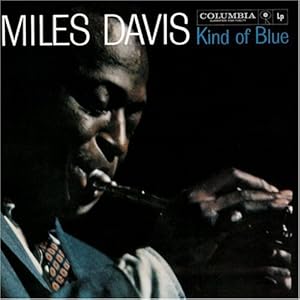
Kind of Blue
Miles Davis 1959
From this album, Kind of Blue, it is easy for me to
understand why so many still appreciate Miles Davis today. The smooth notes he
brings out of the trumpet in his melodies bring a calming and soothing rhythm
to the soul. The long notes of the trumpet settle on the ear in their perfect
consonance. Davis
begins with upbeat melodies and uses the cymbol on the drums to keep the beat, which
is subtle and not overbearing as a drum would be. Except in Blue in Green, this is my favorite song
from this album. I love how the piano and trumpet dance together in this duet.
I feel as though I am dancing with them when I listen. After Blue in Green, the album picks back up
with All Blues that has a
metropolitan feel of the 1950’s era; it’s mysterious sounding. Throughout the
entire album, the rhythmic world of Miles Davis carries me away and I forget
the past week’s troubles. That is why I love to listen to this album,
especially after a long week of work. I
would also suggest glass of pinot noir to compliment this album.
Subscribe to:
Posts (Atom)
